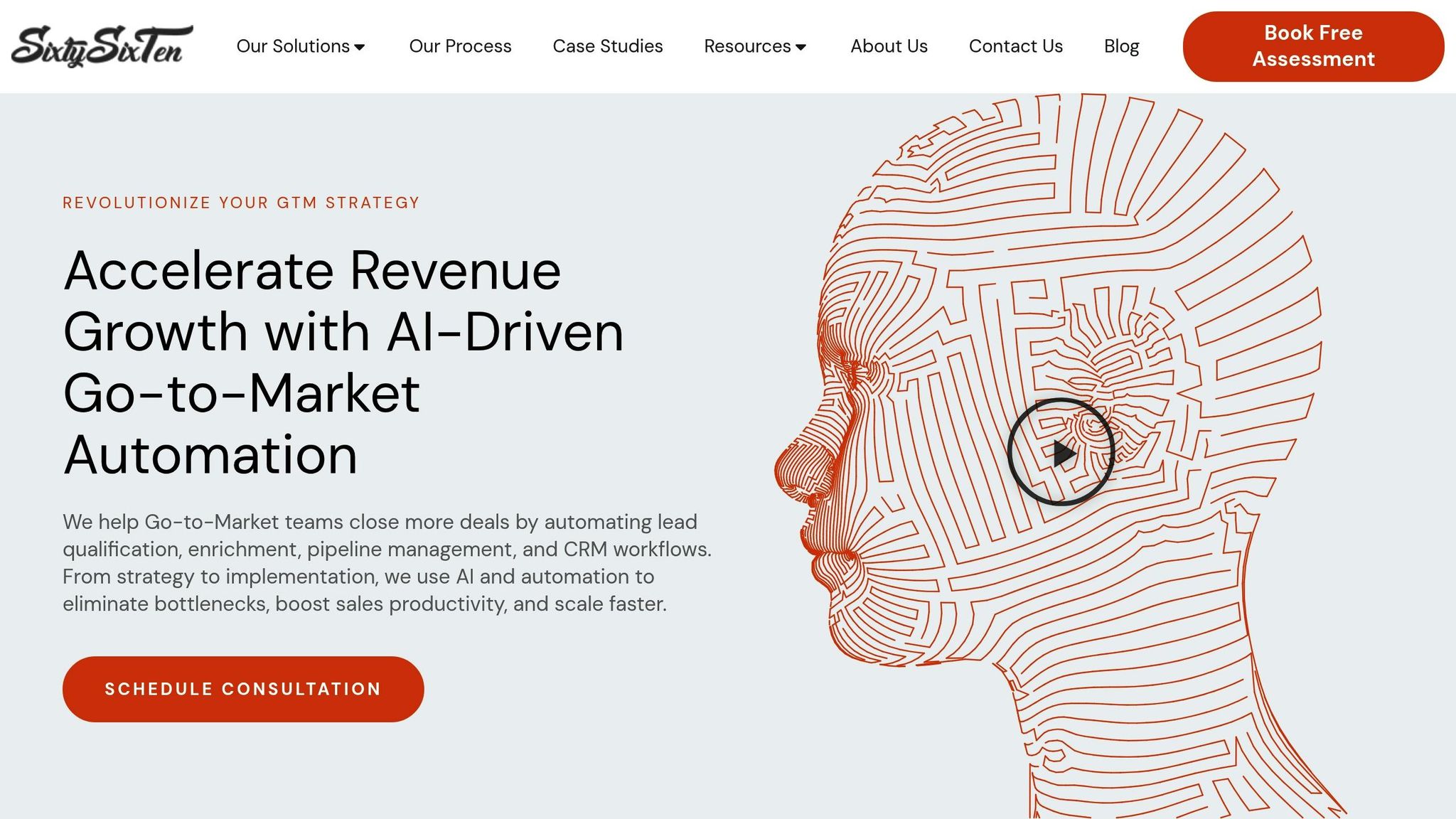Revenue Operations (RevOps) and Sales Operations (Sales Ops) are two distinct approaches to optimizing business processes, especially for B2B SaaS companies. Here’s the main takeaway:
- RevOps focuses on aligning sales, marketing, and customer success teams to improve the entire revenue lifecycle. It’s about creating a unified strategy for long-term growth and customer retention.
- Sales Ops is dedicated to improving sales team efficiency by refining tools, processes, and data management within the sales department.
Quick Overview:
- RevOps: Broad scope, cross-departmental, reports to senior leadership (CRO, CEO), tracks metrics like ARR, CLV, and revenue retention.
- Sales Ops: Narrow focus on sales, reports to sales leadership (VP of Sales), tracks metrics like win rates, deal size, and sales cycle length.
Key difference: RevOps takes a holistic approach to revenue alignment, while Sales Ops zeroes in on optimizing sales performance.
Quick Comparison
| Factor | RevOps | Sales Ops |
|---|---|---|
| Scope | Sales, Marketing, Customer Success (and Finance) | Sales department only |
| Goal | Align revenue teams for growth | Improve sales team efficiency |
| Metrics | ARR, CLV, retention rates | Win rates, deal size, sales cycle length |
| Reporting | CRO, CEO, or COO | VP of Sales, CSO |
| Tools | BI tools, CDPs, revenue intelligence platforms | CRM systems, sales forecasting tools |
If you’re scaling a SaaS business, choose RevOps for broader alignment or Sales Ops for targeted sales improvements. Many companies benefit from combining both approaches.
Revenue operations vs sales operations: What’s the difference?
Scope and Organizational Focus
Let’s dive into how Revenue Operations (RevOps) and Sales Operations (Sales Ops) differ in their organizational scope and the departments they support.
What Departments Do They Support?
Revenue Operations (RevOps) takes a broad, integrated approach by coordinating key revenue-driving teams across the entire customer lifecycle. RevOps typically supports sales, marketing, and customer success, and in some cases, extends to finance – especially when financial planning and revenue forecasting need to sync closely with other departments. This unified approach ensures every revenue-generating function works together seamlessly, using consistent data and shared objectives.
Sales Operations (Sales Ops), on the other hand, has a narrower focus. Its primary role is to streamline processes and provide tools, insights, and support for the sales team to help them close deals more effectively. While Sales Ops may occasionally collaborate with marketing or customer service, its core responsibilities are firmly rooted in the sales department. Key tasks include managing CRM data quality, generating sales reports, and optimizing territory assignments – all of which free up sales reps to concentrate on selling. In some companies, Sales Ops operates within a larger RevOps framework.
Reporting Structure and Leadership
RevOps teams typically report to senior executives, such as the Chief Revenue Officer (CRO), Chief Executive Officer (CEO), or Chief Operating Officer (COO). This high-level reporting reflects their cross-functional role and their responsibility for driving the company’s overall revenue strategy.
Sales Ops teams, by contrast, usually report to sales leadership – like the Head of Sales, VP of Sales, or Chief Sales Officer (CSO). In rare instances, they may report directly to the CEO or COO, but their focus remains aligned with sales-specific goals.
Next, we’ll explore how these structural differences influence their goals and performance metrics.
Comparison Table: Scope and Focus
| Factor | Sales Ops | RevOps |
|---|---|---|
| Departmental Scope | Sales department only | Sales, Marketing, Customer Success (Finance, occasionally) |
| Primary Focus | Improve sales team efficiency and productivity | Align revenue-generating functions across the customer lifecycle |
| Typical Reporting | Sales leadership (e.g., Head of Sales, VP of Sales, CSO) | Senior leadership (e.g., CRO, CEO, COO) |
| Strategic Influence | Focus on sales-specific tools and processes | Drive company-wide revenue alignment and strategy |
| Collaboration Style | Primarily within sales, occasional cross-department work | Continuous cross-department collaboration |
These distinctions shape day-to-day responsibilities and career trajectories: RevOps professionals develop cross-functional expertise, while Sales Ops specialists build deep knowledge of sales processes and tools.
Goals and Key Metrics
While both RevOps and Sales Ops aim to drive revenue growth, the metrics they rely on highlight their distinct areas of focus. Let’s break down the specific goals and measurements that showcase how each function contributes to business growth.
RevOps Goals and Metrics
Revenue Operations takes a holistic approach, focusing on aligning all revenue-generating teams to ensure long-term growth.
Key metrics include Annual Recurring Revenue (ARR), Monthly Recurring Revenue (MRR), Customer Lifetime Value (CLV), Net Revenue Retention (NRR), and Gross Revenue Retention (GRR). These figures provide a comprehensive view of how well the overall revenue engine is performing.
Metrics like revenue retention reveal opportunities for cross-selling, upselling, and reducing churn. By tracking Customer Acquisition Cost (CAC) across all channels, RevOps can evaluate the efficiency of go-to-market strategies. Pairing this with the CAC to CLV ratio ensures growth remains financially sustainable. Additionally, time to value metrics help gauge how quickly customers experience the benefits of a product, directly influencing retention and expansion efforts.
To identify bottlenecks and improve processes, pipeline velocity is monitored, showing how quickly prospects move through the sales funnel. These metrics collectively enable RevOps to create strategies that drive consistent, scalable growth across departments.
Sales Ops Goals and Metrics
Sales Operations zeroes in on improving the sales team’s performance by refining processes, tools, and data accuracy to close deals faster.
Key metrics include win rates, close rates, average deal size, and sales cycle length. These provide insights into the team’s effectiveness and productivity. Pipeline coverage ratios help ensure there are enough qualified opportunities to meet revenue goals.
Sales Ops also tracks daily activity metrics – such as calls per day, emails sent, and meetings scheduled – to measure individual rep productivity and uncover areas for coaching. Metrics like lead response time and follow-up frequency ensure the team capitalizes on marketing-generated leads, maximizing conversion rates.
Quota attainment is another critical measure, providing a clear picture of whether sales targets are realistic and achievable. Meanwhile, sales productivity metrics, like revenue per rep, offer insights into how well tools and processes are supporting the team. Lastly, CRM data quality metrics – covering data completeness and accuracy rates – ensure the sales team has reliable information for forecasting and decision-making.
Comparison Table: Goals and Metrics
| Aspect | Sales Ops | RevOps |
|---|---|---|
| Primary Objective | Optimize sales team efficiency and deal closure | Align revenue teams for long-term growth |
| Core Revenue Metrics | Win rates, average deal size, sales cycle length | ARR/MRR, Net Revenue Retention, CLV |
| Efficiency Focus | Sales rep productivity, quota attainment | Cross-department alignment, time to value |
| Pipeline Metrics | Pipeline coverage, lead response time | Pipeline velocity across the entire journey |
| Customer Metrics | Deal conversion rates, opportunity stages | CAC, CAC to CLV ratio |
| Operational Metrics | CRM data quality, activity tracking | Revenue retention, expansion revenue |
| Success Measurement | Sales team performance against targets | Overall revenue engine performance |
The key distinction lies in their scope and timeframe. Sales Ops focuses on short-term sales performance and immediate deal closures, while RevOps takes a broader view, prioritizing long-term revenue growth and customer relationships across the organization. These differences guide how each function sets goals, allocates resources, and executes strategies to drive business success.
sbb-itb-647c22e
Tools, Technology, and Automation
The tools and technology used by Revenue Operations (RevOps) and Sales Operations (Sales Ops) are a clear reflection of their distinct roles and priorities. Each function’s tech stack is carefully chosen to support its unique focus within the revenue process, highlighting the different ways they contribute to organizational goals.
Core Tools for RevOps
RevOps teams rely on tools that unify data across departments and provide a comprehensive view of the customer journey. Their focus is on cross-functional analytics, automation, and integrated reporting to streamline operations and drive insights.
- Analytics and Business Intelligence (BI): Platforms like PowerBI and Google Looker are central to RevOps. These tools consolidate data from various revenue functions into unified dashboards. PowerBI’s strong integration capabilities make it particularly effective for managing complex tech ecosystems.
- Automation Platforms: Tools like n8n and Zapier automate workflows across departments. For example, n8n supports custom integrations, while Zapier enables quick connections between popular SaaS tools. These platforms handle tasks like lead handoffs, customer onboarding, and renewal notifications.
- Customer Data Platforms (CDPs) and Data Warehouses: These tools create a single source of truth for customer data by integrating information from CRM systems, marketing automation platforms, customer success tools, and product usage analytics.
- Revenue Intelligence Platforms: These platforms help RevOps teams forecast deals, identify opportunities for expansion, and manage churn by analyzing customer lifecycle data.
The RevOps tech stack is built for integration and collaboration, contrasting with the more sales-focused tools used by Sales Ops.
Core Tools for Sales Ops
Sales Ops teams prioritize tools that directly enhance the productivity of sales teams and improve the efficiency of the sales process. Their choices focus on functionality that drives immediate results.
- CRM Platforms: Tools like Salesforce, HubSpot, and Pipedrive are the backbone of Sales Ops. These platforms manage leads, opportunities, and customer relationships, tailored to align with sales workflows.
- Sales Forecasting and Territory Planning: These tools analyze historical data to optimize quota distribution, territory assignments, and pipeline forecasting, ensuring sales targets are realistic and gaps are addressed.
- Sales Enablement Platforms: Tools such as Outreach, SalesLoft, and Gong help standardize outreach, analyze call recordings for coaching, and maintain consistent messaging across the sales team.
- Lead Routing and Assignment: Automation tools streamline the distribution of inbound leads based on criteria like territory or product specialization, ensuring quick responses and accurate CRM data.
- Sales Productivity Tools: Platforms for email tracking, meeting scheduling, proposal generation, and e-signatures directly impact deal closures and improve efficiency.
As Ivan Bondokov, Co-Founder of RevBrains, emphasizes:
"The right tech stack is the linchpin of effective RevOps, laying down the infrastructure for seamless operations and accurate analytics. Clean data is the lifeblood that fuels this infrastructure, enabling precise decision-making and strategic insights. At RevBrains, we grasp the symbiotic relationship between a robust tech stack and pristine data and emphasize their paramount importance in our client engagements. A well-architected tech stack paired with clean data is not just about optimizing operations, it’s about propelling businesses into a realm of sustained revenue growth and operational excellence."
Comparison Table: Tools and Automation
| Tool Category | Sales Ops Focus | RevOps Focus |
|---|---|---|
| Primary Platform | CRM systems (Salesforce, HubSpot) | Data warehouses and analytics platforms |
| Analytics Tools | Sales dashboards, pipeline reports | Cross-functional BI tools (PowerBI, Looker) |
| Automation Focus | Lead routing, email sequences | Cross-department workflows (n8n, Zapier) |
| Forecasting | Sales-specific forecasting tools | Revenue intelligence across all teams |
| Data Integration | CRM-centric integrations | Enterprise-wide data consolidation |
| Performance Tracking | Individual and team sales metrics | Customer lifecycle and retention analytics |
| Workflow Automation | Sales process optimization | End-to-end customer journey automation |
| Reporting Scope | Sales team performance | Company-wide revenue performance |
The key distinction lies in scope and integration complexity. Sales Ops tools are tailored to improve the efficiency of the sales team, while RevOps tools are designed to connect processes across departments, offering a comprehensive view of revenue generation. This difference shapes not only the tools each team selects but also how they are implemented and managed.
When choosing tools, both functions must weigh factors like integration capabilities, scalability, and data quality. While RevOps often requires advanced integration to unify diverse systems, Sales Ops focuses on tools that deliver immediate improvements in productivity and performance tracking.
Impact on Business Growth and Customer Experience
Deciding between RevOps and Sales Ops can significantly influence a company’s growth trajectory and the experience it offers to customers. Each approach carves out distinct paths to success, shaping operational efficiency and revenue outcomes in unique ways.
RevOps Contributions
RevOps fuels growth by breaking down departmental silos and optimizing the entire customer journey. This unified approach brings measurable improvements across multiple areas of the business.
Breaking Down Silos for Unified Growth
RevOps creates a seamless framework where teams collaborate using shared customer data and integrated workflows. This alignment leads to better conversion rates and higher customer satisfaction. For example, marketing qualified leads can transition effortlessly to sales, while customer success teams start with a full understanding of new accounts from day one.
Data-Driven Decision Making Across Functions
With RevOps, decision-making is guided by comprehensive lifecycle data rather than isolated departmental metrics. This broader view enables companies to focus on boosting customer lifetime value and overall revenue. It also helps uncover bottlenecks that may go unnoticed when analyzing individual departments in isolation.
Enhanced Customer Journey Optimization
RevOps teams work to ensure a consistent and smooth customer experience at every touchpoint. By analyzing data from the first interaction to renewal, they identify ways to increase satisfaction and reduce churn. This end-to-end visibility allows businesses to proactively tackle issues before they escalate, building the foundation for sustained sales improvements.
Sales Ops Contributions
While RevOps focuses on the bigger picture, Sales Ops hones in on improving sales efficiency and performance. This targeted approach delivers immediate results, such as better productivity and faster deal closures.
Maximizing Sales Team Productivity
Sales Ops minimizes administrative burdens and streamlines processes, allowing sales reps to spend more time selling. Tools like automated lead routing, proposal generation, and follow-up sequences free up time, leading to higher quota attainment and shorter sales cycles.
Addressing Sales-Specific Bottlenecks
Sales Ops excels at identifying and resolving issues within the sales process. By analyzing pipeline data, they can pinpoint where deals are stalling. They also optimize territory assignments to balance workloads and implement coaching programs based on performance insights. These efforts lead to faster conversions and improved deal velocity.
Supporting Effective Sales Enablement
Using insights from successful sales interactions, Sales Ops develops training programs, messaging strategies, and competitive intelligence to help reps close more deals. They ensure that sales teams have the tools, knowledge, and skills needed to succeed in their specific markets.
Benefits for B2B SaaS Companies
For post-product-market-fit B2B SaaS companies, scaling comes with unique challenges that both RevOps and Sales Ops can address, albeit in different ways. The choice often depends on where the company encounters the most friction during growth.
RevOps Benefits for SaaS Growth
Adopting RevOps often leads to improved net revenue retention rates. Teams collaborate to identify upsell opportunities and mitigate churn risks. The unified data approach also enhances forecasting accuracy and resource planning across all revenue-generating functions.
Sales Ops Benefits for SaaS Scaling
For SaaS companies experiencing rapid growth, Sales Ops ensures that sales processes remain efficient as teams scale. Whether it’s adding new sales reps or entering new markets, Sales Ops helps maintain or improve metrics like average deal size and sales cycle length, even during periods of rapid expansion.
SixtySixTen’s GTM Automation Expertise
SixtySixTen leverages engineering-driven GTM automation to support both RevOps and Sales Ops strategies for post-PMF B2B SaaS companies. Using platforms like n8n, Zapier, Clay.com, and custom AI tools, they design workflows that eliminate manual tasks across CRM, email, ads, and reporting systems.
By combining no-code solutions with custom development, SixtySixTen creates dashboards and systems that unify data and provide real-time visibility into GTM performance. This tailored approach enables companies to implement the right mix of RevOps and Sales Ops capabilities, depending on their growth challenges and organizational needs.
Whether the focus is on comprehensive RevOps integration or targeted Sales Ops improvements, the key is building systems that offer clear performance insights and automate repetitive tasks. This allows teams to concentrate on strategic efforts that enhance customer experience and drive revenue growth.
Choosing the Right Approach for Your Business
Deciding on the best operational strategy for your business depends on where you’re experiencing challenges and what stage of growth you’re in. Many companies find success with a hybrid approach or by transitioning from one strategy to another as their needs evolve.
Matching Operations with Business Goals
Your operational strategy should directly address your business’s pain points and align with your overall goals.
- Opt for Sales Ops if your sales team struggles with time-consuming administrative tasks or inefficient lead qualification. This is ideal for businesses with established marketing and customer success teams that already function smoothly on their own.
- Go with RevOps if disconnected departments are negatively impacting your customer experience. Signs include leads that don’t convert, high churn rates due to poor handoffs, and conflicting data across teams. RevOps is a better fit if you have the resources for cross-functional changes and are prepared to wait 6–12 months to see results.
- Consider a hybrid approach if you’re a mid-sized company dealing with both siloed departments and sales-specific challenges. Start with Sales Ops to tackle immediate productivity issues, then expand to include marketing and customer success alignment as your team grows.
For smaller companies with fewer than 50 employees, the simplicity of Sales Ops often works best. In contrast, larger organizations with multiple departments tend to benefit more from RevOps, thanks to its focus on cross-departmental integration. Sales Ops typically requires less upfront investment, while RevOps demands more resources for managing broader changes.
By choosing the right approach, you can lay the groundwork for tailored automation solutions that meet your business’s unique needs.
How SixtySixTen Can Help

If you’re looking to implement the right strategy quickly, SixtySixTen specializes in delivering targeted go-to-market automation solutions that support both Sales Ops and RevOps – or a combination of the two. They transform manual processes into scalable, automated workflows.
Whether you’re streamlining Sales Ops or building a comprehensive RevOps framework, SixtySixTen uses platforms like n8n, Zapier, Clay.com, and PowerBI to design systems that align perfectly with how your business operates. Their expertise ensures that automation tools – ranging from CRM to email, ads, and reporting systems – work seamlessly together.
SixtySixTen begins by analyzing your current processes to identify areas for improvement. From there, they create custom automation workflows that eliminate manual tasks and enhance efficiency. Their solutions are especially tailored for post-PMF B2B SaaS companies that are navigating the challenges of scaling. They understand how rapid growth can create operational bottlenecks and design systems that handle increasing complexity without breaking down.
Their AI-powered tools also support both Sales Ops and RevOps goals, offering features like lead scoring, automated prospecting, and sales enablement. These tools integrate easily with existing systems, providing real-time data visibility to drive informed decisions across your revenue-generating teams.
Perhaps the biggest advantage? SixtySixTen’s systems grow with your business. Whether you start with focused Sales Ops automation or dive into full RevOps integration, their solutions adapt as your organization’s needs and priorities evolve.
FAQs
How can a business decide between using RevOps, Sales Ops, or both?
Choosing between Revenue Operations (RevOps) and Sales Operations (Sales Ops) – or even combining the two – comes down to your company’s specific goals and how you operate.
If your aim is to bring all revenue-focused teams together, boost collaboration across departments, and create smoother processes, RevOps might be the way to go. But if your main concern is fine-tuning your sales team’s performance and handling their daily operations, sticking with Sales Ops could be enough.
Some businesses find success by blending both approaches. This often involves clearly defining responsibilities, consolidating data, and using technology to drive efficiency and grow revenue. The best choice depends on where your organization stands in terms of maturity, what you’re trying to achieve, and how complex your revenue systems are.
What are the main advantages of adopting RevOps in a B2B SaaS company?
Adopting Revenue Operations (RevOps) in a B2B SaaS company offers a range of benefits that can transform how the business operates. It helps drive revenue growth, boosts customer retention, and improves efficiency by ensuring teams like marketing, sales, and customer success work in sync. By breaking down silos, RevOps creates a unified approach where everyone is focused on shared goals.
Another advantage of RevOps is its ability to deliver deeper data insights, which lead to more accurate forecasting and smarter decision-making. By refining workflows and using tools like CRM platforms and analytics software, businesses can achieve steady growth and scale effectively, even in a competitive landscape.
What are the key differences in tools and technologies used by RevOps and Sales Ops, and how do they influence business growth?
RevOps relies on integrated platforms like Salesforce, HubSpot, and Marketo to bring sales, marketing, and customer success teams together. These platforms serve as a central hub for data, streamline workflows through automation, and deliver real-time insights. The result? Teams collaborate more effectively and make quicker, more informed decisions. This unified strategy minimizes inefficiencies and helps maintain steady revenue growth.
In contrast, Sales Ops zeroes in on sales-specific tools tailored for pipeline management and process improvement. Think CRM systems and task automation tools – designed to boost the productivity of sales teams. While these tools are excellent for refining sales processes, RevOps takes a broader approach. By aligning all revenue-focused teams under one tech stack, RevOps ensures a smoother, data-driven revenue cycle that supports overall business growth.



